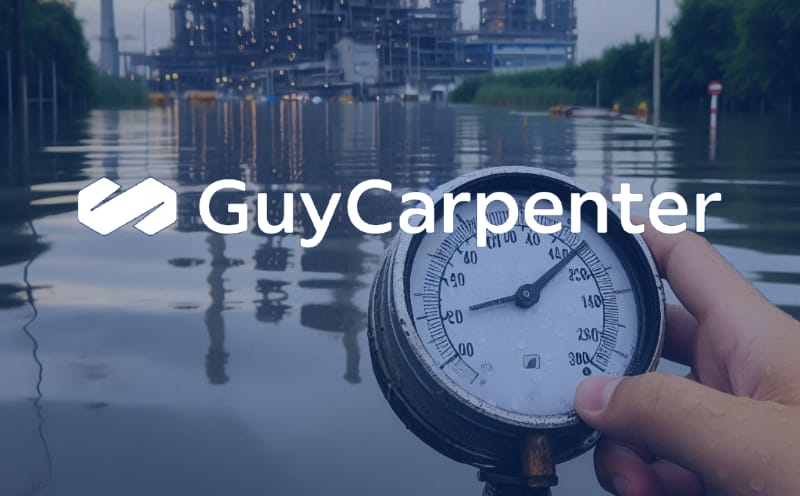Guy Carpenter launches FloodShield, near real-time parametric flood cover

Reinsurance broker Guy Carpenter is rolling out a new parametric flood product that has been designed to enable risk transfer for large portfolios of exposure across wide-areas. The FloodShield triggers are structured with the help of Floodbase, KatRisk, and ICEYE, plus this could be a solution that utilises ILS market capacity in future.
Parametric flood insurance and reinsurance products have become more widely available in recent years and broker Guy Carpenter has developed a solution that can provide customised flood coverage based on hazard footprints that are obtained in near real-time.
GC FloodShield promises payouts within weeks, with the coverage designed to be clear and transparent to both the protection buyer and seller.
The FloodShield parametric product is also designed to be flexible, offering the ability for recoveries to be applied to flood event economic losses, while its parametric trigger can be customised to suit the use-case and protection buyer, with a range of coverage solutions available to suit budgets.
Guy Carpenter’s FloodShield parametric flood risk transfer solution is also designed to have broad applicability and can scale to support large portfolio coverage, with users expected to be insurers, reinsurers, corporations and public entities.
Guillermo Franco, Managing Director & Global Head of Cat Risk Research at Guy Carpenter, revealed the new product on LinkedIn.
Franco explained, “We are rolling out GC FloodShieldSM, a new mechanism for parametric flood (re)insurance, geared towards the risk transfer of large portfolios distributed across vast regions.
“Thank you to our colleagues at Guy Carpenter and our collaborators at Floodbase, KatRisk, and ICEYE.”
Franco also shared a product sheet, that provides detail on GC FloodShield.
The trigger and parametric structure of a FloodShield cover is designed around a high-resolution grid, with the clients exposure aggregated across it and limits applied to each cell that are commensurate with the exposure contained in each.
When a potentially damaging flood event occurs, Guy Carpenter will work with the agreed reporting agent to retrieve a flood footprint and monitor the potential for the parametric trigger to be breached and for any payouts to come due.
A parametric loss is defined as being equal to the product of the exposure times the proportion of flooding in a particular cell, with cell-level parametric losses evolving across the event, as the flood footprint does, and a total parametric loss for the transaction being equal to the sum of maximum losses to each cell at the time of calculation.
Being parametric in nature, the risk transfer will cover any loss, from property to business interruption, with payouts expected within weeks.
Limits available are indicatively said to be up to $100 million via traditional insurance and reinsurance markets, but intriguingly Guy Carpenter’s marketing materials for the parametric FloodShield product note that higher limits may be available via the use of insurance-linked securities (ILS).
As a result, the broker expects the markets backing the FloodShield product to be insurers, reinsurers and also ILS funds, or capital markets investors.
Impressively, this new parametric flood risk transfer solution will be available globally, with flood footprint providers selectable by the client and the trigger parameters based on inundation area percentage within each grid cell.
As a result, FloodShield risk transfer arrangements structured by Guy Carpenter could have attachment and exhaustion points and provide a sliding scale payout amount, based on the observed severity of flooding across the cells, to ensure payouts match the impact to the exposures covered, it seems.
Floodbase, an insurtech that acts as a data provider and reporting agent, satellite owner and data solutions provider ICEYE and probabilistic modelling specialist and NFIP catastrophe bond modeller Katrisk, are all working as flood footprint providers for the GC FloodShield product, with each having different approaches and technologies to bring to the parametric risk transfer solution.
Which means there are a range of options for clients and risk transfer buyers, depending on what might work best for the exposure being covered, the region the parametric cover is focused on, or individual preference and thoughts on optimal design.
FloodShield is an impressive parametric flood solution and the global nature, wide-area capabilities, plus design of the parametric grid approach, as well as high limits said to be available and ability to tap the ILS market for capacity, all suggest this could be a solution that, with time, produces a parametric flood catastrophe bond.
That would be ground-breaking. The only previous cat bond that covered flood risks on a parametric basis was the Blue Wings Ltd. transaction from 2007, but its trigger design was, although highly innovative for the time, far more rudimentary.
It’s going to be intriguing to watch how this GC FloodShield product gets used and whether significant limits are indeed needed by buyers, which could result in a new source of parametric flood risk for the ILS market and perhaps parametric flood cat bonds in time.
Overall, this is a product that shows what is becoming possible in risk transfer, with the use of near real-time data, satellites, synthetic aperture radar (SAR) data, risk modelling and advanced structuring techniques.
It’s precisely why Artemis has been covering parametric risk transfer for more than a decade.
As these parametric structures and transactions deliver more scale and cover wider areas, leverage advanced technology and structuring to reduce basis risk, and ultimately the triggers become more tightly calibrated while transactions much larger and so require much more limit, the capital markets and ILS investors stand to benefit from a new source of parameterised risk to allocate to, which will be welcomed by many.






